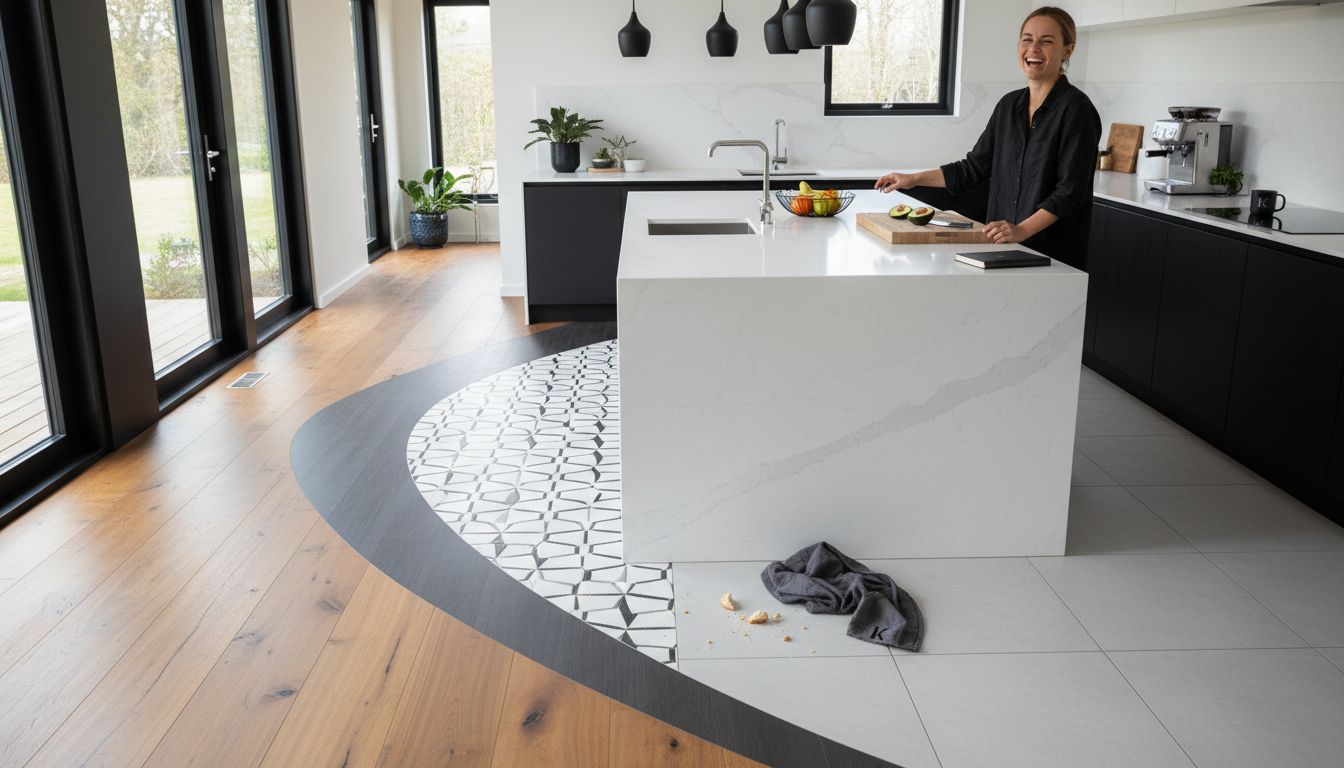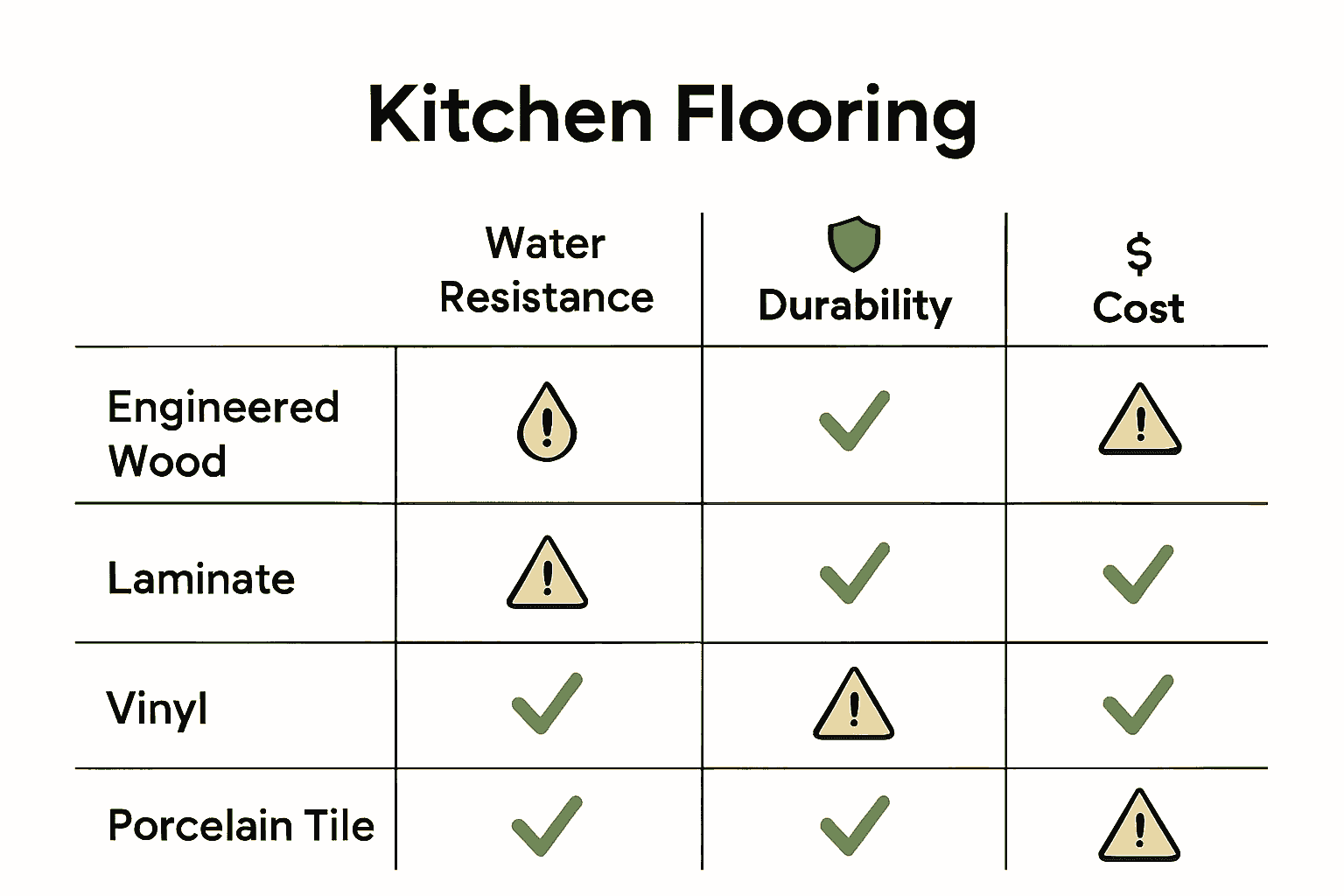Kitchen Flooring Options: Complete Guide for 2024
- demoore5506
- Nov 14
- 6 min read

Choosing the right kitchen flooring can feel like a huge decision when you realize that kitchen floors endure more spills and traffic than any other room in the house. What you put underfoot affects comfort, cleaning routines, and even your home’s style. With so many materials promising durability and beauty, finding an option that stands up to daily life and fits your budget takes careful thought. This guide lays out popular flooring choices and what makes each one a fit for your home.
Table of Contents
Key Takeaways
Point | Details |
Flooring Options | Choose among engineered wood, laminate, vinyl, and porcelain tile based on aesthetics, durability, and budget needs. |
Maintenance and Durability | Consider moisture resistance and maintenance requirements, as vinyl and porcelain tiles typically excel in high-traffic kitchen areas. |
Installation Considerations | Proper installation is crucial for long-term performance and may require professional help to avoid warranty issues. |
Cost Insights | Analyze both initial costs and long-term value, including maintenance and durability, to make a financially sound flooring choice. |
What Are Kitchen Flooring Options?
Kitchen flooring is more than just a surface you walk on—it’s a foundational element that impacts your kitchen’s functionality, style, and durability. According to Consumer Reports, homeowners have several strategic options when selecting kitchen flooring that balance aesthetics, performance, and budget.
The primary kitchen flooring options include:
Engineered Wood: A sophisticated choice offering wood’s natural beauty with enhanced moisture resistance
Laminate: Budget-friendly and highly durable, mimicking wood or stone appearances
Vinyl: Water-resistant and incredibly versatile with numerous design possibilities
Porcelain Tile: Extremely hard-wearing and available in countless design configurations
Each flooring type presents unique advantages tailored to different household needs. For busy families in Ottawa, durability and easy maintenance often become paramount considerations. We’ve explored the best kitchen flooring options for high-traffic households in our comprehensive guide, which can help you make an informed decision.
When selecting kitchen flooring, consider factors beyond just appearance. Evaluate moisture resistance, cleaning requirements, comfort underfoot, installation complexity, and long-term durability. Your kitchen floor represents a significant investment that should withstand daily wear while complementing your home’s overall design aesthetic.

Major Kitchen Flooring Types Explained
Understanding the nuanced characteristics of kitchen flooring types is crucial for making an informed decision.
Remodeling Costs provides comprehensive insights into the diverse range of flooring options available for modern kitchens, highlighting the unique attributes of each material.
Ceramic and Porcelain Tile
Ceramic and porcelain tiles represent a classic and durable kitchen flooring solution. These materials offer:
Exceptional water and stain resistance
Wide range of design and color options
High durability under heavy foot traffic
Easy to clean and maintain
Resistant to temperature changes
Hardwood Flooring
Hardwood flooring brings warmth and natural elegance to kitchen spaces. According to USDA Forest Service, hardwood floors provide distinctive installation options like strip and block flooring, each with unique wear characteristics and maintenance requirements.
When selecting kitchen flooring, homeowners must balance aesthetics, functionality, and budget. How to Choose Paint Finish: Guide for Kitchen Upgrades can offer additional insights into complementing your flooring choice with coordinated design elements.
Durability and Maintenance Considerations
Choosing the right kitchen flooring goes far beyond aesthetic appeal—durability and maintenance are critical factors that impact long-term satisfaction and performance. Consumer Reports provides comprehensive insights into how different flooring materials withstand daily kitchen challenges.
Maintenance Complexity by Material
Vinyl Flooring
100% waterproof
Extremely easy to clean
Resistant to spills and stains
Minimal maintenance requirements
Laminate Flooring
Realistic wood-like appearance
Requires dry cleaning methods
More sensitive to moisture
Regular sweeping and careful cleaning needed
Performance Under Stress
According to Home Base Project, different flooring materials offer varying levels of durability. Vinyl stands out for its exceptional water resistance, while laminate provides a beautiful wood-like aesthetic with more maintenance considerations.
When evaluating kitchen flooring durability, consider factors like foot traffic, potential moisture exposure, and your household’s specific needs. Cabinet Refinishing Durability: Complete Guide can offer additional insights into creating a resilient kitchen environment that balances style and practicality.
Installation Methods and Suitability
Selecting the right installation method is crucial to ensuring your kitchen flooring performs optimally and maintains its aesthetic appeal. JJVS Flooring Site highlights that proper installation involves more than just laying down materials—it requires careful preparation and professional expertise.
Key Installation Considerations
Laminate Flooring Installation
Requires 48-72 hours of acclimation before installation
Needs expansion gaps every 40 feet
Professional installation recommended to prevent warranty issues
Precise measurements critical for long-term performance
Cost and Professional Requirements
According to Remodeling Calculator, ceramic tile installation costs can range dramatically from $613.50 to $9,327 for a 150 square foot area, depending on material quality and labor complexity. This wide range underscores the importance of understanding your specific installation requirements.
When planning your kitchen flooring project, consider factors like subfloor condition, room layout, and your own DIY capabilities. Understanding Durable Cabinet Paint: A Comprehensive Guide can provide additional insights into creating a cohesive and durable kitchen environment that goes beyond just flooring.
Costs, Longevity, and Common Pitfalls
Navigating kitchen flooring investments requires careful consideration of long-term value beyond initial price tags. National Wood Flooring Association provides critical insights into life cycle cost analysis, revealing that some flooring options offer surprising economic advantages when evaluated over decades.
Cost Breakdown by Material
Flooring Cost Considerations
Ceramic Tile: $9.50 to $15.50 per square foot installed
Solid Wood: Lower cost per year over 75-year lifespan
Long-term durability impacts overall investment
Installation quality significantly affects longevity

Common Installation Pitfalls
Remodeling Costs highlights critical vulnerabilities in different flooring materials. Ceramic tile, while moisture-resistant, remains susceptible to cracking from heavy object impacts. This underscores the importance of careful material selection and professional installation.
When budgeting for kitchen flooring, homeowners should look beyond initial costs and consider maintenance requirements, potential repair expenses, and expected lifespan. Cabinet Refinishing Durability: Complete Guide can help you understand how strategic home improvements contribute to long-term value and aesthetic appeal.
Refresh Your Kitchen Style Without the Hassle of Full Renovation
Choosing the right kitchen flooring means balancing durability, style, and maintenance. The article highlights challenges like moisture resistance, foot traffic wear, and the high costs often involved in extensive kitchen makeovers. If you are looking to enhance your kitchen’s look and feel while avoiding the chaos and expense of a full renovation, focusing on cabinet refinishing could be your best solution. With the right cabinet refinishing, you achieve a high-end, modern appearance that complements any flooring choice, preserving your kitchen’s layout and minimizing disruption.
At Ottawa Cabinet Painting, our expert team specializes in transforming tired cabinets into stunning focal points through meticulous prep work and premium paint application that lasts. Take the smart path to a refreshed kitchen that feels warm and functional. Explore how to complement your new or existing flooring with a cabinet finish that stands the test of time by visiting our cabinet refinishing durability guide. Ready to upgrade your kitchen’s heart today without the hassle of a full replacement? Contact us now via our main page for a quote and let us help you create the kitchen you deserve.
Frequently Asked Questions
What are the most common kitchen flooring options?
The most common kitchen flooring options include engineered wood, laminate, vinyl, and porcelain tile, each offering unique advantages like durability, moisture resistance, and aesthetic appeal.
How do ceramic and porcelain tiles differ in kitchen flooring?
Ceramic tiles are generally more porous and less dense than porcelain tiles, making porcelain a better choice for high moisture areas as it offers superior water and stain resistance.
What maintenance is required for vinyl flooring in the kitchen?
Vinyl flooring is 100% waterproof, easy to clean, and resistant to spills and stains, requiring minimal maintenance, typically just regular sweeping and occasional mopping.
How can I ensure proper installation of laminate flooring?
To ensure proper installation of laminate flooring, acclimate the material for 48-72 hours, leave expansion gaps, consider hiring professionals, and take precise measurements to enhance performance and prevent warranty issues.
Recommended
Comments